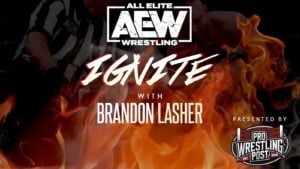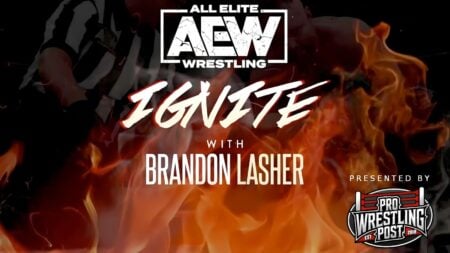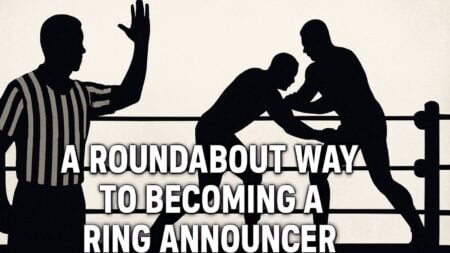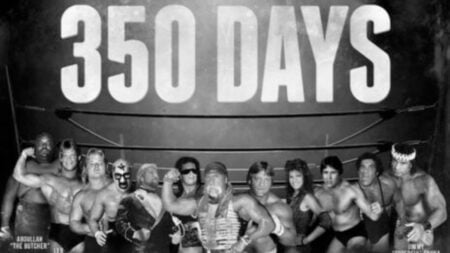The Four Horsemen of the Apocalypse are figures described in the Book of Revelations in the Bible. Though English translation varies, they arrive to herald the world’s end, sent by the Lord to patrol the earth.
As one translation has it, “Causing it to rest quietly known as “sword, famine, wild beasts, and plague” or “given authority over a quarter of the earth, to kill with sword, famine, and plague, and using the beasts of the earth.”
More commonly, they are named War, Famine, Pestilence, and Death. The key is they are invested with authority and are harbingers of doom.
_____________________
After his alliance with Blackjack Mulligan and Greg Valentine came to an end in 1981, Ric Flair formed a new group with allies with whom he shared past ties.
During his time in Mid-Atlantic Championship Wrestling, Flair was said to be a cousin of the Minnesota Wrecking Crew, Ole, and Gene Anderson. But when the Four Horsemen were originally formed, Ole was part of the group and not Gene.
Arn Anderson came in as a ‘cousin’ of Ole, though he did not have any actual genetic ties to the elder Anderson. When the group was formed, there was no longer any mention of Flair having a familial relationship with the Andersons.
Tully Blanchard joined Flair, Ole & Arn Anderson to create the group’s original version, with J.J Dillon representing them as their manager. And thus, in 1985, the Four Horsemen were born.
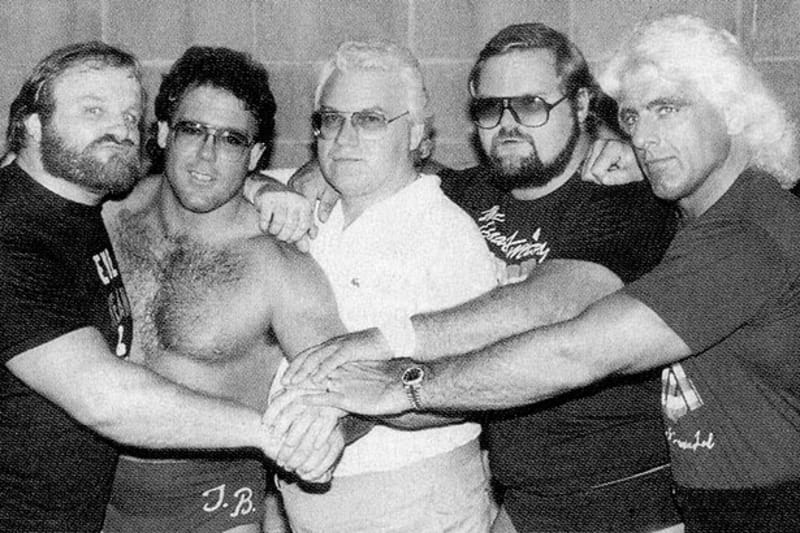
“Well, I was at the right place at the right time. I’ve known Flair for over 40 years. I met him first when I was a main eventer in Amarillo, Texas, and he had been in the Carolinas with Crockett.
They saw something magical in him, and that was before cable television, so only people in the Mid-Atlantic knew him.
They wanted to send Ric out to other areas, and they sent him to Texas, where I was. I spent the whole week with him, and we have a lot in common. It was the beginning of a lifelong friendship.”
JJ Dillon on becoming the manager of the Four Horsemen. (h/t 411Mania.com via WrestlingInc Podcast)
The Thin Line Between Arrogance and Confidence
A standard element of their promos was that they enjoyed the finer things in life, whether that was flying on jet planes, riding in limousines, or striking up ‘deals.’ And in the world outside wrestling, the Four Horsemen were a unit that lived their personas.
Arn and Flair have admitted their brash and confident personas were an extension of who they were outside the ring. At a time when it was crucial to protect kayfabe, Flair, Arn, and Blanchard were as thick as thieves both in and out of the ring.
What’s in a name?
While today the Four Horsemen have a legacy of greatness, the name came about almost accidentally. It was reported that, during an interview with Flair, Blanchard, Ole, and Arn, one line resonated so much that it led to the name sticking.
After beating down the ‘American Dream’ Dusty Rhodes, Arn would state the following.
“So, there we stood, four of us, and they started into their promos, whoever went ahead of me, I don’t remember. And I was just looking and counting heads, and I don’t know how or why, but The Four Horsemen of the Apocalypse in the biblical story of what they do and when it’s time, it popped into my head.
Now, I’m a religious guy and certainly believe in God, but I’m not a bible thumper that it was in my pre-frontal lobe; it just popped in there, like promos, right?
We don’t know how it pops in there we just roll with it. And I went into this deal. Hey, you’re dealing with, you know, you’re looking at Four Horsemen, and never has so much damage been done to so many by so few.”
– Arn Anderson on the origins of the Four Horsemen (h/t The Signature Spot via Talk is Jericho)
This interview took place at the Omni in Atlanta, Georgia, and the Four Horsemen name stuck. During this time, these antagonists needed protagonists to fight. At various times the ‘American Dream,’ Barry Windham, The Road Warriors, and the Rock N’ Roll Express battled the Horsemen.
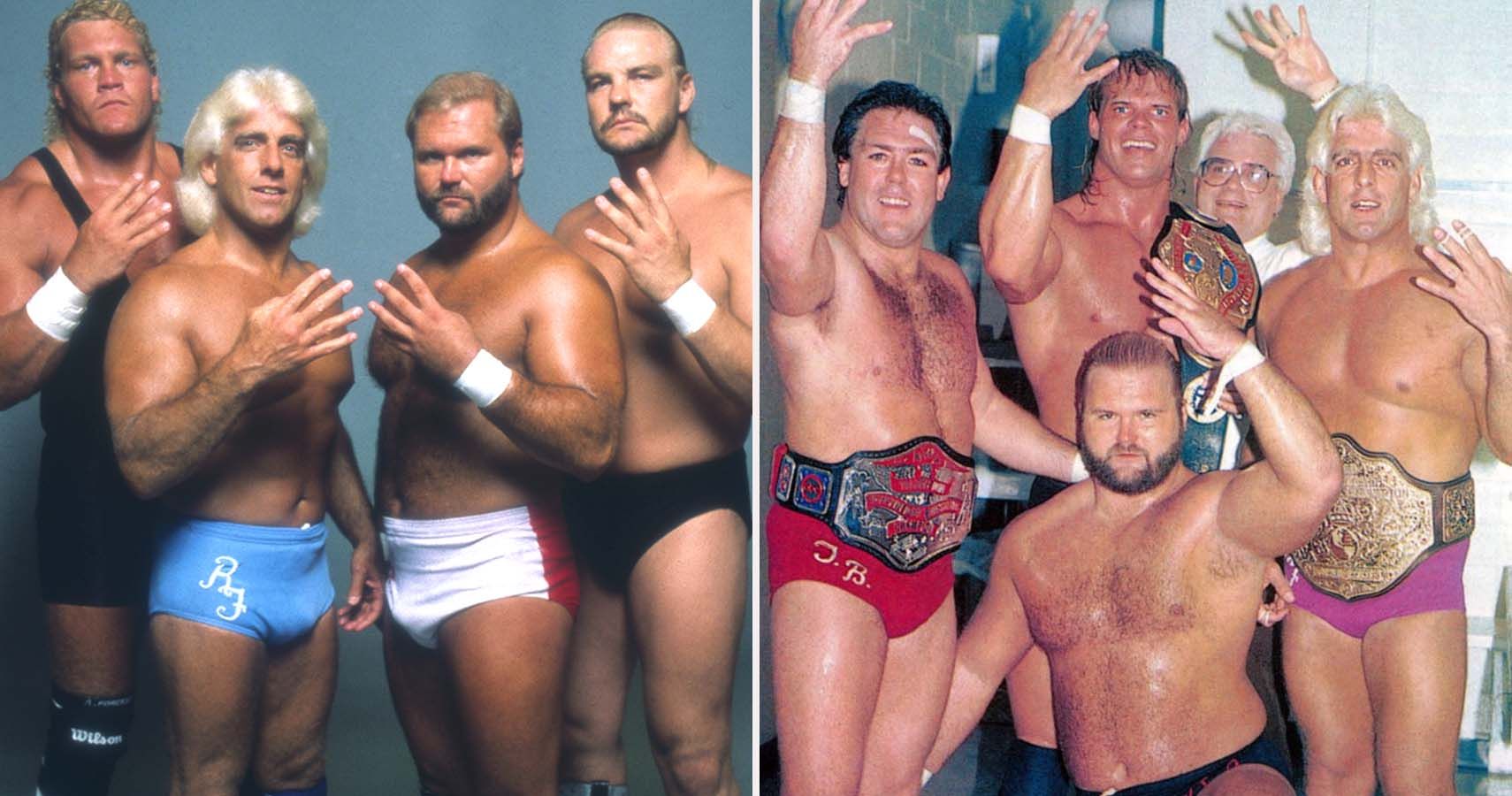
‘The Total Package’ Lex Luger was brought in after original member Ole Anderson was excommunicated from the group. This was not just due to Luger’s desire to be a part of the group; it also introduced a much younger asset.
However, Luger’s time in the faction would be short-lived, as he accused J.J Dillon of costing him the NWA United States Championship and was kicked out of the group.
During an NWA World Tag title defense, Luger and his partner Barry Windham defended against Anderson and Blanchard. However, during the match, Windham would turn on Luger and join Anderson, Blanchard, and Flair to round out the Horsemen.
So, each member of this incarnation of the faction was holding championships, as the World, the United States, and World Tag Team titles were all in the possession of the Horsemen.

“For my part, it was crazy. You had Ole and Arn and Flair was their cousin, so it was a family deal. And my only entrance to the whole deal was I was wrestling Dusty.
So, when they wanted to have all those eight-man tag matches, and Dusty was in them, I was very fortunate to be the, ‘Well, we’re putting Tully in there.’ So, since I was the only one outside the family that was part of it, it was probably a double accident for me.”
Tully Blanchard on the formation of the Four Horsemen (h/t 411Mania via ARN)
The Departure of Tully Blanchard and Arn Anderson
In the Fall of 1988, Blanchard and Anderson left the NWA to join the WWF. These two men, that were synonymous with the Horsemen, were managed by Bobby ‘The Brain’ Heenan and known as ‘The Brainbusters.’
In the absence of Anderson and Blanchard, Windham and Flair, with JJ Dillon by their side, would often still be referred to as Horsemen.
Several different wrestlers were aligned with them, though they were not necessarily official Horsemen, per se. Kendal Windham and Butch Reed were among those who were allies, if not members.
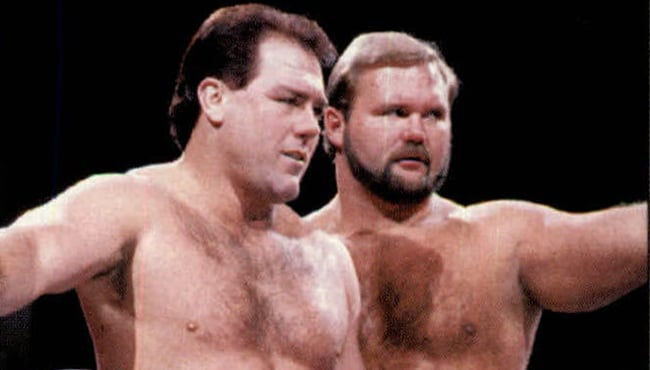
Eventually, Flair was so embarrassed by what took place when Ricky Steamboat teamed with Eddie Gilbert to defeat him and Barry Windham that he fired JJ Dillon from representing them.
‘The Master of the Japanese Sleeper’ Hiro Matsuda would replace Dillon in that role, and although considered a Horsemen by association, he wasn’t technically called one.
Regardless, the Horsemen name was no longer used, and instead, they were known as the Yamazaki Corporation. Windham’s US title loss to Lex Luger also resulted in a broken hand, and soon after, he left the faction and the promotion altogether. Matsuda’s departure would ultimately end the Corporation.
By December 1989, after Arn Anderson returned to the promotion, he, Ole, and Flair would reunite to reform The Four Horsemen. Sting was added to round out the faction, making them faces. However, Sting’s inclusion in the group was short-lived as he was kicked out for wanting to challenge Flair for the World Championship.

“Sting, you never were a Horseman”
– Ric Flair
Ole would retire from the ring by the Spring of 1990, and so a returning Barry Windham and Sid Vicious would join them, making the Four Horsemen complete. At this time, Woman also joined the group and accompanied Flair to the ring as his valet.
By 1991, this grouping of the Four Horsemen would also separate. Flair and Sid departed for the WWF, Anderson would form a tag team with Larry Zbysko, and Barry Windham became a face and contended for the World Championship.
A couple of years passed, and the Horsemen would once again reform. However, this incarnation would only include three members, as Flair and Arn were joined by Paul Roma. Ole acted in a managerial and advisory role for the trio.
Sadly, a real-world incident between Arn and Sid contributed to the group dissolving. Roma would team up with ‘Mr. Wonderful’ Paul Orndorff to form ‘Pretty Wonderful,’ and Flair would pursue the WCW Heavyweight Championship alone.

The Reemergence of The Four Horsemen
A couple of years after the Horsemen disbanded, a new opportunity would come about. It was a feud with Hulk Hogan and Randy Savage that would lead things to reform the Horsemen.
As the story unfolded, Flair and Anderson had apparently split up, and their on-screen bickering led to a match between the two.
With the aid of Brian Pillman, Anderson would defeat Flair. As a result, Flair would approach one of his greatest rivals, Sting, for help. While he never appeared to trust Flair fully, Sting ultimately decided to tag with him against Anderson and Pillman.
But at Halloween Havoc ’95, Flair would turn on Sting, leading to the reformation of the Horsemen. As time passed, Chris Benoit would join the group, making it a proper quartet. They would feud with the other top names of WCW, including Hogan, Sting, Luger, and Savage.
But eventually, Pillman left the promotion, creating a hole in the group. But then, in the Summer of 1996, former NFL player Steve ‘Mongo’ McMichael would turn on his tag team partner, the late Kevin Greene, and became the new fourth member of the Horsemen.
“Jeff Jarrett was never a Horseman”.
– Arn Anderson
Not too long after, Jeff Jarrett joined the promotion and voiced to his idol, Flair, his desire to be a part of the faction. While he never officially joined, he had Debra McMichael (Mongo’s wife) as his manager.
The animosity between Women and Debra contributed to McMichael’s eventual departure from the Horsemen. Jarrett tried to take his place, but Arn categorically denied Jarrett’s membership in the Horsemen in his autobiography.
With Arn Anderson’s retirement, the decision was made that Curt Hennig would take his place in the Horsemen.
However, Hennig betrayed Flair and Benoit, which led to the group once again dissolving in the Fall of 1997. However, in the Fall of 1998, Flair returned after he had been absent for a short while due to behind-the-scenes with Eric Bischoff.
After Flair’s return, Anderson, Benoit, and Dean Malenko would join him to reform the final incarnation of the group. Soon after, McMichael would step in for Anderson. Arn was working in more of an advisory role rather than as a competitor.
The End of The Four Horsemen
McMichael would eventually leave wrestling, and the group was down to three members. At one point, David Flair would sport Horsemen t-shirts, but he was never officially a Horsemen. Flair was on the on-screen President of WCW and even awarded his son the title. It was the epitome of nepotism.
Because of this behavior, the faction’s originator would be the one that would cause the demise of its last incarnation, as Benoit and Malenko would leave the faction, Flair’s greed being the root cause.
It’s just hard (to make this happen) because I work all the time,” Flair said. “Arn works all the time, Barry has had some health issues, and J.J. works at a correctional institute.
But it’s all good because we’re all getting together. The first appearance we did was so successful; it was scary.”
Ric Flair on a Four Horsemen reunion (h/t ProWrestling.Com)
